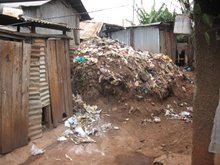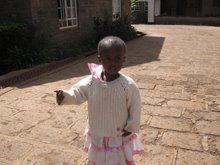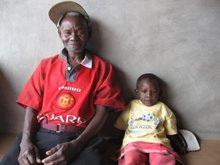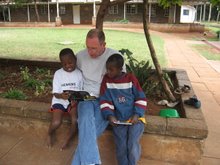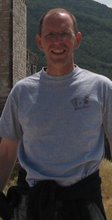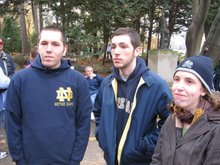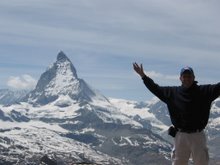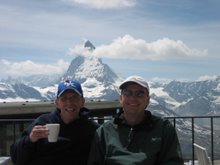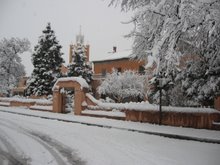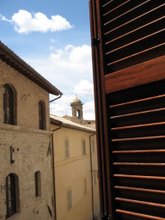I could sleep a little over night to Nairobi and once on the ground at 7:00 a.m. began the long wait to get my Visa. $50.00 American and you are all set. I walked from the lines to see my name on a card “Welcome Ed” and met my driver, Gabriel. He had been waiting for quite a while and took me to his old van for the 45 minute ride to Nyumbani. At once I was struck with the hundreds of Africans walking along the roads, in the roads. It was the rush hour and many were headed to work. They followed dirt paths along the road. We past through a couple of checkpoints with armed soldiers and stop-spikes diverting traffic and slowing it.
We traveled past the outskirts of Karen, a more wealthy area of walled properties, until we got to Nyumbani. The place was like a small compound, again with a guard at the gate to let us in. Everyone has security. It seems that most white folks have drivers. I was greeted on the driveway by Sr. Julie, a Franciscan sister from Philly. She directed us around to Noel House, rooms for volunteers. Sr. Julie was very kind and introduced me to Jim, a volunteer and my roommate for the days I would be at Nyumbani. Jim is a retired Hospital guy, not sure if he is a nurse, although I think so. He is in his 60s. I also met Protus, a Kenyan and Director of the Children’s Home. He is very friendly, charismatic and grateful for my visit. I met all kinds of staff, secretaries, Sr. Teresa Little (Sr. Little) who runs the Leatoto program.
I then made the walk up the hill to meet Sr. Mary Owens, BVMI. Sr. Mary is the Director of all Nyumbani operations. With the death of Fr. D’Agostino in November, Sister Mary took over as director. She has been with Nyumbani since the beginning, was instrumental in its founding and I believe is more of the nuts and bolts, practical side to Fr. D’Ag's visionary gifts. Sr. Mary sat down and talked to me a little of my trip and let me know that I would be able to meet with her later at 4:00. She insisted that I sleep. It was 9:30 a.m.
 I headed back to the guest house and took a cold shower, not knowing that the solar panels won’t heat the water enough til the afternoon. I didn’t think I was tired but closed my eyes and slept for three hours. When I woke up, Sr. Julie was waiting to take me on a tour of the place. We visited the cottages, 8 of them surrounding a playground in a “village setting” We met one of the “mom’s” who care for the 96 children when they arrive home from school. They all attend public school. Some of the older children are being transferred to one of the newer buildings, more suitable for teens and adolescents. They are just about complete but there is some talk of the change in the dynamics of the cottages, once the older children leave. It is very African for the older children to help with the younger. This changes things a bit.
I headed back to the guest house and took a cold shower, not knowing that the solar panels won’t heat the water enough til the afternoon. I didn’t think I was tired but closed my eyes and slept for three hours. When I woke up, Sr. Julie was waiting to take me on a tour of the place. We visited the cottages, 8 of them surrounding a playground in a “village setting” We met one of the “mom’s” who care for the 96 children when they arrive home from school. They all attend public school. Some of the older children are being transferred to one of the newer buildings, more suitable for teens and adolescents. They are just about complete but there is some talk of the change in the dynamics of the cottages, once the older children leave. It is very African for the older children to help with the younger. This changes things a bit.We went to the infirmary to meet Moses, the nurse/physician at the clinic. This is a well-equipped blood lab/clinic which is also open to the public for HIV testing etc. We met Ken, a young boy who came to Nyumbani in January. He was not responding well to treatment and had an IG tube recently inserted for nourishment. He looked more typical of AIDS children you would see on TV. He was frail, weak, looked malnourished. He was laying quietly, covered up. I saw him later, sitting outside, wrapped up in the sun, silent, big dark eyes.
We took a walk to the cemetery. There have been close to 69 deaths at the orphanage over the years. Many fewer lately due to the advent of ARVs (Antiretroviral drugs - medications for the treatment of infection by retroviruses, primarily HIV. Different classes of antiretroviral drugs act at different stages of the HIV life cycle. Combination of several (typically three or four) antiretroviral drugs is known as Highly Active Anti-Retroviral Therapy (HAART).
USAID now provides ARVs to people needing these medications in Kenya. In fact USAID funds the Lea toto outreach program of Nyumbani. We’ll talk about that later. With the coming of ARVs, the children in Nyumbani can, with a good regimen of drugs, good nutrition and care, live long productive lives. Once off the medications, the virus quickly reappears. I witnessed the children all wearing sweaters and sweatshirts, some coughing and dealing with respiratory
 issues. So there have been close to 69 deaths over the years at Nyumbani, sometimes as many as three a month. We passed a little shamba (garden) pigs, roosters, and a trash burning incinerator smoking up the place!
issues. So there have been close to 69 deaths over the years at Nyumbani, sometimes as many as three a month. We passed a little shamba (garden) pigs, roosters, and a trash burning incinerator smoking up the place!Most of these children were abandoned, left for dead, sick and nameless. Their parents may have died, their parents may have left them to fend for themselves. I was interested in their names (Lazusus, Moses, Joseph, Mercy, Faith, Mohammed!) We stopped in to check out the preschool / daycare and blow bubbles with the children. They were great fun but you could see that they looked much younger than their cronological age. The disease and their environment sets most of the students back about 5 years developmentally. Some children who you would guess were about 10 or 11, were actually 15 or older. They all seemed the same size!
We returned to the buildings for lunch at 1:00. A mix of beans, rice, corn carrots and a little gravel thrown in! It was sort of a soupy stew. The African staff took huge helpings. Sr. said a few volunteered daily so they would have at least one meal. The cooking staff, I will learn, is great fun.
The children start returning from various schools around 1:30. After changing out of their school uniforms, the kids play for a while and then have tutoring and chores. Each afternoon they hand wash their uniforms and shine their shoes for the next day. Everything is orderly and cleanliness is of great value and stressed. There is always sweeping and scrubbing floors and walks. The “moms” take pride in the area around the cottages and children are sometimes seen picking up individual fallen leaves outside. The children haul big tubs with wet clothes to be hung on clothes lines. There are approximately 14 children per cottage. Various ages and cottages A and B (All Boys) are all boys. Food is cooked at the main kitchen and the “moms” or a child goes and picks up the bowls or pots and brings the food to the cottage. The utensils, plates etc. are all there and the dishes are done there. Volunteers go to the cottages to spend time with the children after dinner. Homework time, stories and chores.

I met with Sr. Mary again at 4:00. we talk about each program and my expectations. I will be fortunate to spend the next day with her from very early – as we will drive to Nyumbani Village in Kitui the next morning.



